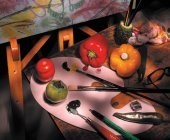|
Texture in photographyElement of texture in photography gives additional information of the surface finish and feel of an object. Texture in a photograph shows the nature of the surface. It shows how the surface of the object feels, when you touch it. Any object can be smooth and shiny like a polished metal or a plastic ball. It can be semi matt like surface of a skin or an orange, or matt like clothes and bricks. Reflectivity of the surface also counts. A smooth surface may have reflective or non-reflective surface. (surface of smooth unpolished wood is not reflective but matt.) We must bring this feel of touch in a photograph. This nature of the surface is emphasized with the correct type of lighting.
Polished article with shiny surface will require soft light. Light will be recorded as reflection in the high-light. (high-light in reflective surface is actually the reflection of the source of the light) In a photograph of this type of object, there is no much mid-tone area, where actual color and texture of the product is visible. So secondary fill-in light as reflectors are required. Form of the object will come out as the shape of high-light, which will follow the contour of the object. That is why a simple shape like square or rectangle of main light source is a must. Semi matt and matt surface will require medium and hard light, though we can use soft light as fill-in. Umbrella can be used to make the light source, medium as the surface will not reflect the shape of the source of the light. If we want to capture a texture, we will need angular oblique spot or hard light. As spot light creates sharp shadows, it will create very sharp and tiny shadows within the surface, and texture will be visible. This element of photograph enhances the visual appeal and many time works on its own.

Small object like food grain and cloth has to be given maximum importance for the element of texture. Texture in photography brings out the reality in the object. It shows how the subject feels. There may be a time where we do not want to capture the reality, especially in subjects like a child or a female model. In such case, we may avoid capturing the texture with the use of soft, frontal light and soft focus filter.
Return back to elements of image
|






